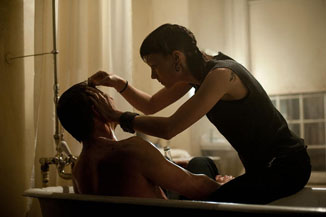|
|
Movie Review: The Girl With the Dragon TattooBy Matthew HuntleyJanuary 4, 2012
Given his recent reputation, Blomkvist is surprised when he receives a call from Dirch Frode (Steven Berkoff), assistant to Henrick Vanger (Christopher Plummer), a wealthy industrialist whose family’s business was once the biggest and most profitable in all of Sweden (Vanger now jokes their most successful product is fertilizer). Vanger invites Blomkvist out to his family’s private island in Hedestad and hires him to do two things: 1) write his memoirs; and 2) attempt to solve the murder of his beloved niece, Harriet, who was presumably murdered over 40 years ago. Every year on his birthday, Henrick still receives a black and white flower drawing, which only Harriet would send, and he believes one of his family members is behind it and trying to torment him. Most of the Vanger family, including Henrick’s nephew (Stellan Skarsgård), live on the island and are a stone’s throw away from one another, but most are estranged and refuse to speak. Blomkvist takes Henrick up on his offer, not only for the money (Vanger promises to quadruple his salary if he solves it) but because Henrick says he has valuable information on Wennerström that Blomkvist could use as ammunition. In a parallel plot, we meet the titular character, Lisbeth Salander (Rooney Mara), a freelance researcher and computer hacker who can dig up information on just about anybody. In fact, it was her research on Blomkvist that led Frode to contact him in the first place on Vanger’s behalf. Lisbeth is viewed as a sociopath and outcast because of her black clothes, nose rings and tattoos, but don’t let her appearance fool you: she’s resourceful, creative and persistent to the point where you don’t want her on your bad side, something her abusive case worker (Yorick van Wageningen) learns the hard way.
|

|
|
|

|
Thursday, October 31, 2024
© 2024 Box Office Prophets, a division of One Of Us, Inc.


